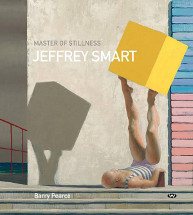Master of stillness, Jeffrey Smart by Barry Pearce

Wakefield Press, Revised edition, 2018. ISBN 9781743053393.
(Age: Senior secondary - Adult) Highly recommended. Non-fiction.
"Master of stillness" is the perfect title for this beautiful book
which through its collection of photographic images traces the
evolution of the art of Jeffrey Smart, born in Adelaide then
eventually resident of Italy for 5 decades. The artworks are grouped
by locations - Adelaide, Sydney, Rome and Tuscany - but if when you
read Rome and Tuscany you expect images of ancient architecture,
villas and rolling hills, you'll be surprised to see here modern
landscapes of fences, roads, and concrete slabs, for it is Smart's
fascination with lines, planes and shapes that dominate his work.
He wrote, "people often think concrete structures ugly... But the
play of light on the precast slabs, the mystery of the building is
beautiful to me."
They are 'still' paintings, quiet, the human figure mostly a minor
point, an intersection of lines, or an indicator of scale. Clearly
Smart had a mastery of the human form, seen most impressively in,
'Wine carriers', 'On the roof, Taylor Square' and 'Morning practice,
Baia' but usually the human figure is strangely lonely in the urban
landscape, the human element even ominously lonely with the
depiction of the empty pram on the beach in 'Holiday resort' and
'Approaching storm by railway'.
Turning the pages of this book, it is fascinating to trace the
development of the artist's discovery of beauty in lines, textures
and shapes, from the early examples of still life, to the buildings
and fences, roads and bridges, leading to his last and ultimate work
'Labyrinth', with the portrait of H.G. Wells, a small figure placed
in the maze of straight stone walls with shadows making triangles
amid the rectangular shapes.
This book is a wonderful celebration of a great Australian artist -
it is a book to treasure, and deserves a place in the art section of
every library.
Helen Eddy